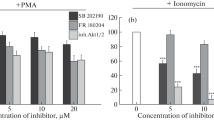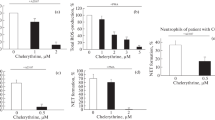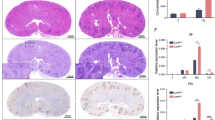Abstract
In humans, Candida albicans is the microorganism most frequently associated with fungal infections. Alterations in the balance between the host and this commensal pathogen, turns into a parasitic relationship which results in the development of invasive infections. Neutrophils via chemotaxis, phagocytosis, and microbicide capacity can eradicate this pathogen. Taken together, the aim of this work was to study the possible role of phosphatidylinositol-3-kinase (PI3K), extracellular signal-regulated kinase (ERK) and the nuclear transcription factor kappa β (NF-kβ) on the phagocytic process of neutrophils. The chemotactic capacity of neutrophils and their ability to phagocytose and to destroy C. albicans in absence and presence of 1, 10, or 100 μM of wortmannin (a PI3K inhibitor); 10, 25, or 50 μM of Bay 11-7082 (a NF-kβ inhibitor) or 1, 5 or 10 μM of PD 98,059 (an ERK inhibitor) were determined. Our results show that fMLP-induced chemotaxis needs the participation of PI3K and NF-kβ. In contrast, ERK seems not to be involved. On the other hand, the inhibition of NF-kβ and ERK decreased neutrophil phagocytosis and microbicide capacity against C. albicans. However, both the phagocytic and candicide capacities were PI3K independent.



Similar content being viewed by others
References
Garber G (2001) An overview of fungal infections. Drugs 61:1–12
Romani L (2004) Immunity to fungal infections. Nat Rev Immunol 4:1–23
Marr KA, Patterson T, Denning D (2002) Aspergillosis: parthenogenesis, clinical manifestations, and therapy. Infect Dis Clin North Am 16:875–894
Bellochio S, Moretti S, Perruccio K, Fallarino F, Bozza S, Montagnoli C, Mosci P, Lipford GB, Pitzurra L, Romani L (2004) TLRs govern neutrophil activity in Aspergillosis. J Immunol 173:7406–7415
Greenberg S, Grinstein S (2002) Phagocytosis and innate immunity. Curr Opin Immunol 14:136–145
Medzhitov R, Preston-Hurlburt P, Janeway CA (1997) A human homologue of the Drosphilia Toll protein signals activation of adaptive immunity. Nature. 388:394–397
Netea MG, Van der Graaf CA, Vonk AG, Verschueren I, Van der Meer JW, Kullberg BJ (2002) The role of toll-like receptor (TLR) 2 and TLR4 in the host defense against disseminated candidiasis. J Infec Dis 185:1483–1489
Hayashi F, Means TK, Luster AD (2003) Toll-like receptors stimulate human neutrophil function. Blood 102:2660–2669
Beutler B (2000) Tlr4: central component of the sole mammalian LPS sensor. Curr Opin Immunol 12:20–26
Francois S, El Benna J, Dang PM, Pedruzzi E, Gougerot-Pocidalo MA, Elbim C (2005) Inhibition of neutrophil apoptosis by TLR agonists in whole blood: involvement of the phosphoinositide 3-kinase/Akt and NF-kappaB signaling pathways, leading to increased levels of Mcl-1, A1, and phosphorylated Bad. J Immunol 174:3633–3642
Yum HK, Arcaroli J, Kupfner J, Shenkar R, Penninger JM, Sasaki T, Yang KY, Park JS, Abraham E (2001) Involvement of phosphoinositide 3-kinases in neutrophil activation and the development of acute lung injury. J Immunol 167:6601–6608
Strassheim D, Asehnoune K, Park JS, Kim JY, He Q, Richter D, Kuhn K, Mitra S, Abraham E (2004) Phosphoinositide 3-kinase and Akt occupy central roles in inflammatory responses of Toll-like receptor 2-stimulated neutrophils. J Immunol 172:5727–5733
Asea A (2003) Chaperokine-induced signal transduction pathways. Exerc Immunol Rev 9:25–33
Ortega E, Hinchado MD, Martín-Cordero L, Asea A (2009) The effect of stress-inducible extracelular Hsp72 on human neutrophils chemotaxis: the role during acute intense exercise. Stress 12:240–249
Fidel PL (2002) Distinct protective host defenses against oral and vaginal candidiasis. Med Mycol 40:359–375
Roeder A, Kirschning CJ, Rupec RA, Schaller M, Korting HC (2004) Toll like receptors and innate antifungal responses. Trends Microbiol 12:44–49
Farnell MB, He H, Genovese K, Kogut MH (2003) Pharmacological analysis of signal transduction pathways required for oxidative burst in chicken heterophils stimulated by a Toll-like receptor 2 agonist. Int Immunopharmacol. 3:1677–1684
Ortega E, Forner MA, Barriga C (1997) Exercise-induced stimulation of murine macrophage chemotaxis: role of corticosterone and prolactin as mediators. J Physiol 498:729–734
Coelho AL, De Freitas MS, Mariano-Oliveira A, Oliveira-Carvalho AL, Zingali RB, Barja-Fidalgo C (2001) Interaction of disintegrins with human neutrophils induces cytoskeleton reorganization, focal adhesion kinase activation, and extracellular-regulated kinase-2 nuclear translocation, interfering with the chemotactic fuction. FASEB J 15:1643–1645
Ortega E, Collazos ME, Maynar M, Barriga C, De la Fuente M (1993) Stimulation of the phagocytic function of neutrophils in sedentary men alter acute moderate exercise. Eur J Appl Physiol Occup Physiol 66:60–64
Ortega E, Marchena JM, García JJ, Barriga C (2005) Norepinephrine as mediator in the stimulation of phagocytosis induced by moderate exercise. Eur J Appl Physiol 93:714–718
Giraldo E, Hinchado MD, Garcia JJ, Ortega E (2008) Influence of gender and oral contraceptives intake on innate and inflammatory response. Role of neuroendocrine factors. Mol Cell Biochem 313:147–153
Nakamae-Akahori M, Kato T, Masuda S, Sakamoto E, Kutsuna H, Hato F, Nishizawa Y, Hino M, Kitagawa S (2006) Enhanced neutrophil motility by granulocyte colony-stimulating factor: the role of extracellular signal-regulated kinase and phosphatidylinositol 3-kinase. Immunology 119:393–403
Firtel RA, Chung CY (2000) The molecular genetics of chemotaxis: sensing and responding to chemoattractant gradients. Bioessays 22:603–615
Stephens L, Ellson C, Hawkins P (2002) Roles of PI3Ks in leukocyte chemotaxis and phagocytosis. Curr Opin Cell Biol 14:203–213
Wymann MP, Sozzani S, Altruda F, Mantovani A, Hirch E (2000) Lipids on the move: phosphoinositide 3-kinases in leukocyte function. Immunol Today 21:260–264
Cloutier A, Ear T, Blais-Charron E, Dubois CM, McDonald PP (2007) Differential involvement of NF-kappaB and MAP kinase pathways in the generation of inflammatory cytokines by human neutrophils. J Leukoc Biol 81:567–577
Pierce JW, Schvenleber R, Jesmok G, Best J, Moore SA, Collins T (1997) Novel inhibitors of cytokine-induced IkBα phosphorylation and endothelial cell adhesion molecule expression show anti-inflammatory effects in vivo. J Biol Chem 272:21096–21103
Downey GP, Butler JR, Tapper H, Fialkow L, Saltiel AR, Rubin BB, Grinstein S (1998) Importance of MEK in neutrophil microbicidal responsiveness. J Immunol 160:434–443
Zu YL, Qi J, Gilchrist A, Fernandez GA, Vazquez-Abad D, Kreutzer DL, Huang CK, Sha’afi RI (1998) p38 mitogen-activated protein kinase activation is required for human neutrophil function triggered by TNF-alpha or FMLP stimulation. J Immunol 160:1982–1989
Kanakaraj P, Duckworth B, Azzoni L, Kamoun M, Cantley LC, Perussia B (1994) Phosphatidylinositol-3 kinase activation induced upon FcgRIIIA-ligand interaction. J Exp Med 179:551–558
Ninomiya N, Hazeki K, Fukui Y, Seya T, Okada T, Hazeki O, Ui M (1994) Involvement of phosphatidylinositol 3-kinase in Fc gamma receptor signaling. J Biol Chem 269:22732–22737
Dewitt S, Hallett MB (2002) Cytosolic free Ca(2+) changes and calpain activation are required for beta integrin-accelerated phagocytosis by human neutrophils. J Cell Biol 159:181–189
Moraes TJ, Downey GP (2003) Neutrophil cell signaling in infection: role of phosphatidylinositide 3-kinase. Microbes Infect 5:1293–1298
Hii CST, Stacey K, Moghaddami N, Murray AW, Ferrante A (1999) Role of the extracellular signal-regulated kinase cascade in human neutrophil killing of Staphylococcus aureus and Candida albicans and migration. Infect Immun 67:1297–1302
Meyer H, Goettlicher S, Mendling W (2006) Stress as a cause of chronic recurrent vulvovaginal candidosis and the effectiveness of the conventional antimycotic therapy. Mycoses 49:2002–2209
Giraldo E, Garcia JJ, Hinchado MD, Ortega E (2009) Exercise intensity-dependent changes in the inflammatory response in sedentary women: role of neuroendocrine parameters in the neutrophil phagocytic process and the pro-/anti-inflammatory cytokine balance. Neuroimmunomodulation 16:237–244
Murciano C, Villamón E, Yañez A, O’Connor JE, Gozalbo D, Gil ML (2006) Imparied immune response to candida albicans in aged mice. J Med Microbiol 55:1649–1656
Polak A (2003) Antifungal agents: advances and problems, Chapter 4. In Jnucker E (ed). Birkhauser Verlag, Basel, pp 59–190
Acknowledgments
This work was supported by grants of II (2PR04A076) and III (PRI06A172) and a fellowship from Consejeria de Educacion, Ciencia y Tecnologia of the Junta de Extremadura, and Fondo Social Europeo, as well as by a fellow from “Fundación Valhondo”.
Author information
Authors and Affiliations
Corresponding author
Rights and permissions
About this article
Cite this article
Giraldo, E., Martin-Cordero, L., Hinchado, M.D. et al. Role of phosphatidylinositol-3-kinase (PI3K), extracellular signal-regulated kinase (ERK) and nuclear transcription factor kappa β (NF-kβ) on neutrophil phagocytic process of Candida albicans . Mol Cell Biochem 333, 115–120 (2010). https://doi.org/10.1007/s11010-009-0211-5
Received:
Accepted:
Published:
Issue Date:
DOI: https://doi.org/10.1007/s11010-009-0211-5




